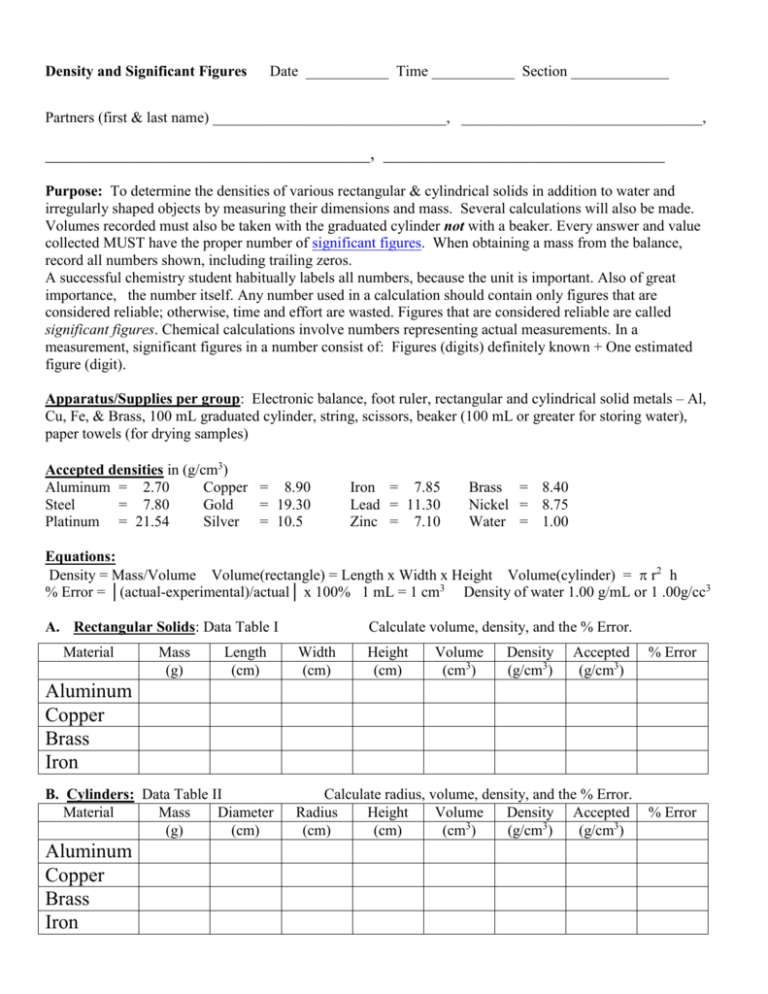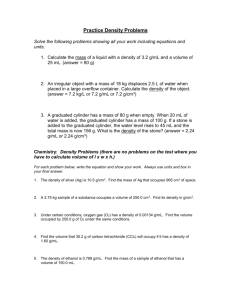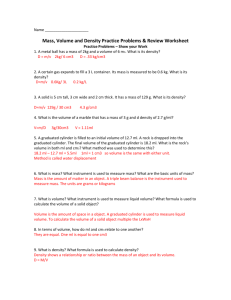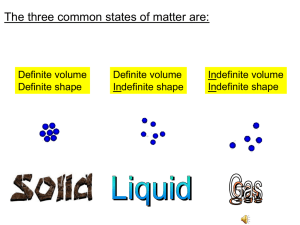F13 Density and Significant Figures
advertisement

Density and Significant Figures Date ___________ Time ___________ Section _____________ Partners (first & last name) _______________________________, ________________________________, _____________________________________, ________________________________ Purpose: To determine the densities of various rectangular & cylindrical solids in addition to water and irregularly shaped objects by measuring their dimensions and mass. Several calculations will also be made. Volumes recorded must also be taken with the graduated cylinder not with a beaker. Every answer and value collected MUST have the proper number of significant figures. When obtaining a mass from the balance, record all numbers shown, including trailing zeros. A successful chemistry student habitually labels all numbers, because the unit is important. Also of great importance, the number itself. Any number used in a calculation should contain only figures that are considered reliable; otherwise, time and effort are wasted. Figures that are considered reliable are called significant figures. Chemical calculations involve numbers representing actual measurements. In a measurement, significant figures in a number consist of: Figures (digits) definitely known + One estimated figure (digit). Apparatus/Supplies per group: Electronic balance, foot ruler, rectangular and cylindrical solid metals – Al, Cu, Fe, & Brass, 100 mL graduated cylinder, string, scissors, beaker (100 mL or greater for storing water), paper towels (for drying samples) Accepted densities in (g/cm3) Aluminum = 2.70 Copper = 8.90 Steel = 7.80 Gold = 19.30 Platinum = 21.54 Silver = 10.5 Iron = 7.85 Lead = 11.30 Zinc = 7.10 Brass = 8.40 Nickel = 8.75 Water = 1.00 Equations: Density = Mass/Volume Volume(rectangle) = Length x Width x Height Volume(cylinder) = r2 h % Error = │(actual-experimental)/actual│ x 100% 1 mL = 1 cm3 Density of water 1.00 g/mL or 1 .00g/cc3 A. Rectangular Solids: Data Table I Material Mass (g) Length (cm) Calculate volume, density, and the % Error. Width (cm) Height (cm) Volume (cm3) Density (g/cm3) Accepted (g/cm3) % Error Aluminum Copper Brass Iron B. Cylinders: Data Table II Material Mass Diameter (g) (cm) Aluminum Copper Brass Iron Calculate radius, volume, density, and the % Error. Radius Height Volume Density Accepted 3 (cm) (cm) (cm ) (g/cm3) (g/cm3) % Error C. Density of Water Procedure: 1. Mass the graduated cylinder in grams (use the electronic balance) and record it on the data table. 2. Fill a small amount of water and measure the mass of graduated cylinder and water. 3. Determine the volume of water. 4. Repeat 1-3, by adding water, 3 more times, the volume changing every time. Data Table III Mass of cylinder + water (g) Mass of the graduated cylinder = ______________g Mass of water (g) Volume of water (ml) Density (g/cm3) Average density D. Density of an irregularly shaped object When a sample of material has no regular geometry its volume can be determined by displacement. To do this, fill a graduated cylinder about half full of water. Read its volume. Drop the object into the water and read the final volume. The difference in volume is the volume of the object. Object #1 __________________ Object #2 __________________ Initial volume: _______________ ml Initial volume: _______________ ml Final volume: _______________ ml Final volume: _______________ ml Volume of the object: _______________ cm3 Volume of the object:_______________ cm3 Mass of the object: _________________ g Mass of the object: _________________ g Density of the object: _______________ g/ml Density of the object: _______________ g/ml E. Volume of an irregularly shaped object When a sample of material has no regular geometry its volume can be determined by density or by manually filling it. Perform both of these methods to see how they compare. What are some sources of error? Container used – please circle round bottle “snowman” bottle (fill to lip below white or garnet ring) Mass of empty, dry, bottle _______ g Mass of full bottle _______ g Bottle volume (calc): ________ cm3 Medical supplies (fill to highest measured volume – 15 mL, 30 mL, 240 mL) Mass of empty, dry med supply _______ g Mass of full med supply _______ g Volume (calc): ________ cm3 Marked volume of the object: ________ cm3 Percent error __________% Sources of error ___________________________________________________________________________









